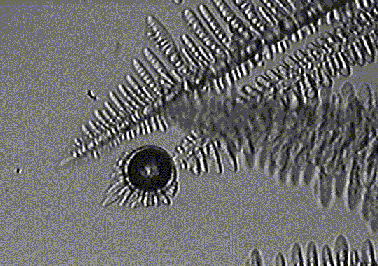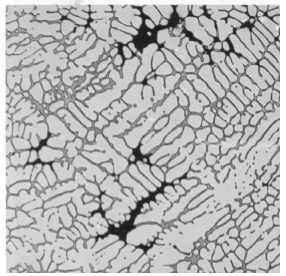Y. Sun and C. Beckermann
The objective of this research project is to advance fundamental understanding of microporosity formation during solidification of alloys. The single most important feature of the research is that it focuses solely on the microscopic scale (on the order of microns) where nucleation, interfaces, growth morphologies, and micro-flows can be directly observed. Previous studies of microporosity formation have only been concerned with larger length scales, and have not resolved the actual solid and pore microstructures. The present study will provide valuable knowledge of pore nucleation and growth rates, microscopic flow and solute fields in the solid-liquid-gas system present during pore formation, and the interactions between the pores and the evolving microstructure. This information can then be used to develop improved averaged descriptions of microporosity formation for use in macro-scale casting simulations. It also allows for the prediction of the exact characteristics of the pores in a fully solid microstructure as a function of the alloy composition and processing conditions.
The research will be accomplished through the combined use of novel modeling, numerical simulation, and experimental techniques. A phase-field method will be developed to model the complex phase transformation and transport phenomena present, including multi-component thermodynamics, curvature effects, and convection. Modern numerical techniques, such as deforming finite element meshes and highly efficient parallel solvers, will be employed to solve the model equations. The experiments will use transparent model alloys inside a Hele-Shaw cell under a high-resolution microscope. In the experiments, the initial gas content and the solidification conditions will be carefully controlled. The model predictions will be validated by the experimental measurements.

The present work finds application in nearly every metal casting process. The problem of microporosity is of renewed interest because of the dramatically increased use of castings in the automotive and aerospace industries. Only the detailed prediction of microporosity can aid in its prevention and in assessing its influence on the strength and fatigue life of cast components. The transfer of the knowledge obtained through the proposed project will take place through continued collaboration with the casting industry, the development of improved microporosity models for use in casting simulation software, and the education of students. From a more fundamental point of view, the project will advance a largely uncharted area of research that is concerned with micro-scale, multi-component, multi-phase systems with phase change. Such systems are important not only in metal casting, but also in other materials processing operations, in nature, and in living organisms.
